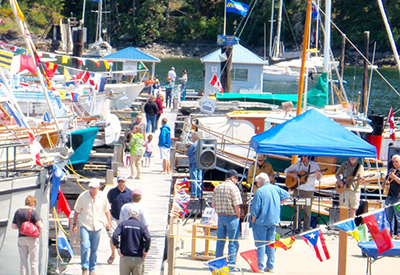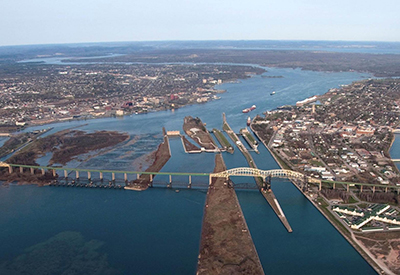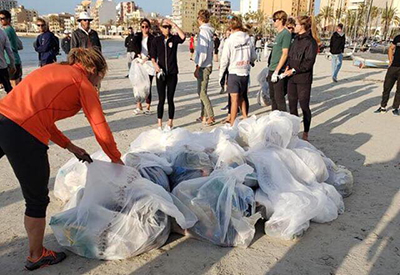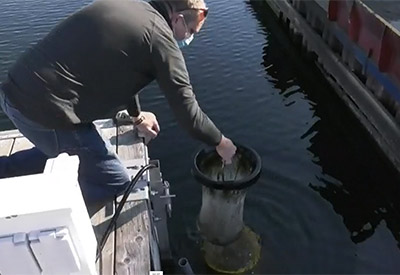Aquatic Invasive Species (AIS) – What Are They – What Can You Do?

By definition, an alien species is a plant or animal occurring in an area outside of its known natural habitat as a result of accidental or intentional introduction by human activities. An alien species is considered invasive if its introduction and spread causes harm to the environment, society or economy.
Throughout history human activities including settlement and trade have caused the introduction of aquatic invasive species (AIS) quite often to the detriment of native ecosystems. Over 200 non-native species of plant and aquatic life have become established in the Great Lakes; this number grows annually. Many of these species are now advancing throughout connecting inland waterways. The same thing is happening in coastal waters and their adjacent inland waterways.
Most AIS are introduced to our Great Lakes and coastal port areas through the illegal dumping of water ballast from commercial shipping. Under international law, ships are required to dump water ballast well off shore before entering coastal and inland waterways. To get an idea of the magnitude of the potential of ballast dumping to introduce AIS here is the recorded global activity of one commercial vessel over a 14 month period:
Ports visited by a single vessel during that time – three in Asia, six in Europe and the Middle East, two in Africa, seven in South America, two in Mexico and the Southern USA and eight in the Great Lakes and North Eastern USA. Water ballast was loaded near fifteen of these ports and was dumped near thirteen. On any given day, an estimated 3,000 species are transported in ballast water and attached to the outside of the vessel’s hull. Water ballast is used to add weight and stabilize vessels in rough seas. These species include fish, snails, clams, aquatic plants and pathogens.
This explains how easily and often AIS are introduced into coastal and Great Lakes waters. Once here, they are usually spread throughout adjoining inland waters by recreational boaters who travel through waterway systems and/or trailer their boats from one lake to another.
Before recommending what boaters can do to stop or slow down the spread of AIS, let’s take a look at a few of the most common AIS and better understand who and what they are.
Zebra Mussels
A zebra mussel is a small freshwater clam with a brown- and cream-coloured striped shell originally from Eurasia, first discovered in Lake St Clair in 1988. They quickly spread throughout the Great Lakes and connecting waterways, have caused enormous changes to the ecosystems and have had major social and economic impacts. Zebra mussels are highly adaptable and can survive in lakes with a wide range of environmental conditions. They filter up to one litre of water every day and feed on tiny organisms in the water that form the basis of the food chain on which aquatic life depends. A female zebra mussel can produce up to one million eggs every year. Reproduction begins when water temperatures reach 12 degrees Celsius. When they hatch, free-floating larvae are dispersed by water currents and wind and wave action. Two to three weeks later they begin to develop their shell and can no longer float so they settle, develop sticky fibers and attach themselves to almost anything. They are soon large enough to be seen
by the human eye, can live up to five years and grow to a length on five centimeters. They can dramatically reduce the amount of food available to fish and other aquatic species.
Their feeding results in clearer water which in turn, allows sunlight to penetrate further forcing light sensitive fish deeper and encouraging the growth of aquatic vegetation including invasive plants like Eurasian Water Milfoil. They foul the bottom of boats, bouys and docks and clog water intakes for homes, cottages and industries thus reducing water flow and costing millions of dollars each year to clean out the intakes for power generating and water treatment facilities.
Eurasian Water Milfoil
Discovered in North America in the 1940s, Eurasian Water Milfoil has spread to virtually every US State and at least three Canadian Provinces. It is a submerged aquatic plant that forms thick mats in the shallow areas of lakes and waterways which in turn hinders swimming, boating, and fishing and reduces property values. Eurasian Watermil Foil can displace native aquatic plants and impact both fish and plant aquatic life. It spreads when pieces break off and are carried to other waters by boats, motors, trailers and fishing gear.
Rusty Crayfish
The Rusty Crayfish is a native of the Ohio River system and was first found in Canada in the Kawartha Lakes in the early 1960s. It is now established throughout southern and northwestern Ontario. It has a brown body and claws with dark black bands near the tips. There are prominent rusty patches, not always visible, on either side of the body and it grows to a length of ten centimeters, not including the claws that are larger and more robust than other Ontario native species. The Rusty Crayfish can live up to four years and lay 50-575 eggs which hatch in three to six weeks so a single crayfish can start a new population once introduced into a new water body. It eats both animal and plant life including snails, leeches, fish eggs, small fish and plants that are used for fish habitat. It consumes up to twice as much as native crayfish.
Fanwort
Fanwort is a submerged aquatic plant commonly sold as an aquarium plant or as an “oxygenator” for outdoor ponds. It is native to South America and was first found northeast of Peterborough in 1991. It is able to live in a variety of habitats and prefers nutrient rich shallow waters with a low pH. Once established, it can form dense stands, displacing native vegetation, clogging drainage canals and streams, and interfering with swimming and boating. Currently, its long-term impact on ecosystems and biodiversity in northern temperate zones is not well understood.
Round Goby
The Round Goby is native to Eastern Europe and was first found in Ontario in the St. Clair River in 1990. It is now the fastest spreading fish in Ontario and is found throughout the inland waters from Georgian Bay south through the Trent Severn waterway. It is a small, bottom dwelling fish that has impacted the Great Lakes fishery. It is mottled brown in colour, has a single pelvic fin, can live up to five years and grow to a length of 25 centimeters. Round Gobies can spawn multiple times each season and in some places densities of Round Goby have reached up to 100 fish per square metre. It eats small organisms; larger Round Goby feed on the eggs and the young of important recreational and commercial fish. They also eat Zebra Mussels, but unfortunately, do not control them. Research is beginning to examine the possible toxic contamination, including Botulism Type E, which might build up in the chain of Zebra Mussels, Round Gobies and the larger fish birds and animals that consume these and end up in the human food chain. Due to the serious impacts caused by the introduction of the Round Goby, regulations have been passed to make it illegal to possess this fish alive.
European Frog-Bit
The European Frog-Bit is a free floating aquatic plant native to Europe and Asia that was originally introduced as an ornamental aquatic plant in Ontario in the 1930s and has since spread to many waters in southern Ontario, Quebec and New York State. It resembles a miniature water lily and has a single white flower, floating leaves and roots that do not anchor the plant to the bottom. A single plant can produce as many as 100 winter buds that break apart from the plant in late fall, sink to the bottom and lay dormant for the winter and then rise to the surface to produce new plants in the spring. European Frog-Bit generally grows in back waters and quiet bays where there is limited wave action. It forms dense, impenetrable mats of floating vegetation that prevent sunlight from reaching the aquatic plants below. Decomposition can reduce dissolved oxygen levels in the water and restrict both swimming and boating. Despite all the documented negative impacts, this plant is not prohibited from entry or sale in Canada.
New Zealand Mud Snail
Native to New Zealand, this Mud Snail was first found in Lake Ontario in 1991 and was probably introduced through Europe. It is now spreading throughout the Great Lakes and many US States. It has no natural predators or parasites and can reach concentrations of 500,000 per square metre thus endangering the natural food chain by outcompeting native snails and water insects, leading to sharp declines. Fish populations whose main food source is our native snails and insects, then suffer. This snail has a “lid” that can seal the opening of its shell. It can live for 24 hours out of water and can survive for up to 50 days on a damp surface giving them ample time to be transferred from one body of water to another on boats and fishing gear. These snails may even survive passing through the digestive system of a fish. The shell can be either gray or brown in colour and typically has five to eight whorls coiling out in a clockwise direction. The shell can be 12 mm long but is typically about 5 mm. In their native habitat the presence of a native parasite that sterilizes many of the snails keeps populations at a manageable level. Elsewhere in the world there is an absence of these natural parasites.
Rudd
The Rudd is a member of the European minnow family and has been introduced to many parts of North America. It was first found in the St Lawrence River near Lake Ontario in 1990 and is now spreading west through Lake Ontario, up the Humber River and into Lake Erie. It is a large, deep-bodied minnow that can grow to a length of 35 cm with a weight of 1.8 kg. It is similar in appearance to our native Gold Shiner but its fins are a blood red where the Gold Shiner’s are yellow. It eats mainly aquatic vegetation and insects and in laboratory conditions can consume up to 40% of its body weight daily. Female Rudd can lay 100,000 to 200,000 eggs per year and these eggs hatch in seven to fourteen days depending on temperature. Rudd may compete with native fish for food and degrade their natural spawning habitats.
How do these and other Aquatic Invasive Species affect you? They can:
• Clog boat engine water intakes and interfere with steering mechanisms
• Clog home and cottage water intakes
• Restrict the use of lakes and waterways
• Reduce the number of popular sport fish, water foul and other aquatic species
• Degrade the natural beauty of our lakes and waterways and
• Reduce property values
What can boaters do to stop or reduce the spread of AIS?
• Before leaving the boat launch remove all aquatic plants, mussels or other organisms and put them in the garbage
• Drain the water from your boat, motor, live well and bilge
• Do not release live bait!
• Empty your bait bucket on land or freeze or salt your bait for future use
• Remove organisms you can’t see on your boat, waders and gear by rinsing with hot water or spraying with high pressure water or drying in the sun for five days
• Remember it is illegal to use Round Goby as bait or possess live Round Goby and never release live bait from one water body to another
• Report sightings of Aquatic Invasive Species to the Invading Species Hotline at: 1 800 563 7711
Much of this information has been edited from publications provided by the Great Lakes Commission through its Great Lakes Aquatic Invasions document and the Ontario Federation of Anglers and Hunters (OFAH). For further information you can contact the OFAH by going to: www.invadingspecies.com.
By John Gullick





























